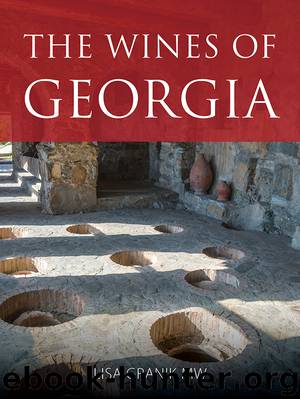The wines of Georgia by Lisa Granik

Author:Lisa Granik
Language: eng
Format: epub
Publisher: Infinite Ideas Ltd
Ikalto
The Akhmeta subzone meanders south-east, following Route 42 to Telavi. Although some vineyards are at different elevations, the highest is at the village of Ikalto, at 700 metres, the rest between 400 and 600 metres elevation. This, plus differing exposures and soils, gives rise to three different zones. The climate is effectively the same as upriver.
Ikalto: the upper zone
Leaving the village of Akhmeta behind, one approaches Kistauri and, a few kilometres down, Ikalto and Vardisubani. Here, especially on the right side of the road, the vineyards are higher, creeping towards the mountain. This upper zone, at 600 to 700 metres elevation, is mostly on calcareous carbonate soils. These vineyards once had healthy percentages of humus but, like elsewhere in Georgia, this depends on farming practices.
Vardisubani is perhaps the zone receiving the most serious study given the means and approach taken by Philippe Lespy at Georgian Wine and Spirits (GWS). Aerial satellite photography illustrates how Vardisubani is divided into two in the middle of the parcel by a former river that once flowed from the mountain to the Alazani. Sitting on a calcareous plateau, 2 metres below the surface the vineyard is a mélange of round river stones and schist that tumbled down the Tsiv-Gombori. They have 5 hectares of older Saperavi vines (no Budeshuri) planted there, which, depending on the soil differences, produce ‘entirely different flavours of Saperavi’, Lespy explains. ‘When we harvest, we have several different types of Saperavi, and then, after fermentation, we can even get one more,’ continues his assistant, Nika Natroshvili. The soil studies have yet to be released, and they are still working to connect the dots between soil growing conditions and grape expression.
Saperavi emits its best characteristics early in the fermentation. ‘We like to keep it as cool as possible, say about 15 degrees,’ Lespy continues. ‘We try for a prefermentation maceration for three to four days. Then the fermentation is warm – up to 33°Celsius.’ Once the fermentation is over, they remove the skins from the wine. While the earlier maceration ‘changes everything’, Natroshvili notes, there is nothing positive to be gained from post-fermentation maceration.
Their single parcel Vardisubani is a white wine, a blend of qvevri-fermented Rkatsiteli, Mtsvane and Kisi. Elevage in used barriques contributes to a qvevri wine in an elegant idiom – clear, integrated, round and soft, but with fresh acidity.
Ikalto: the middle zone
The middle zone is across the Telavi-Akhmeta road on the Alazani side. Passing through Ojio and Ruispiri, the vineyards spread out on the slightest of inclines toward the river at 450 to 550 metres elevation. The exposure is open.
Ojio has long been regarded as a good terroir but had not received the same respect as other localities. More recently, climate change has brought Ojio greater attention. Within the Kakhetian context, Ojio tended to produce wines that have considerably higher acidity and more tension – much more than areas further south-east. Warming temperatures and the desire for wines with more ‘cut’ – from acidity, not just from rustic tannins – have prompted producers to source Ojio fruit or, if possible, acquire property.
Download
This site does not store any files on its server. We only index and link to content provided by other sites. Please contact the content providers to delete copyright contents if any and email us, we'll remove relevant links or contents immediately.
| Buying Guides | Cellars |
| Champagne | Collecting |
| Spirits | Whiskey |
| Wine | Wine Pairing |
| Wine Tasting |
Whiskies (Collins Gem) by dominic roskrow(42214)
101 Whiskies to Try Before You Die by Ian Buxton(42182)
Whiskies Galore by Ian Buxton(40332)
Craft Beer for the Homebrewer by Michael Agnew(17446)
Right Here, Right Now by Georgia Beers(3497)
Not a Diet Book by James Smith(2726)
Water by Ian Miller(2584)
The Coffee Dictionary by Maxwell Colonna-Dashwood(2531)
Kitchen confidential by Anthony Bourdain(2306)
Coffee for One by KJ Fallon(2007)
Smuggler's Cove: Exotic Cocktails, Rum, and the Cult of Tiki by Martin Cate & Rebecca Cate(1979)
Beer is proof God loves us by Charles W. Bamforth(1920)
Superfood Smoothie Bowls: Delicious, Satisfying, Protein-Packed Blends that Boost Energy and Burn Fat by Chace Daniella(1903)
Talking as Fast as I Can by Lauren Graham(1832)
Bourbon: A Savor the South Cookbook by Kathleen Purvis(1791)
A Short History of Drunkenness by Forsyth Mark(1720)
Eat With Intention by Cassandra Bodzak(1688)
Cocktails for the Holidays by Editors of Imbibe magazine(1626)
Colombia Travel Guide by Lonely Planet(1609)
